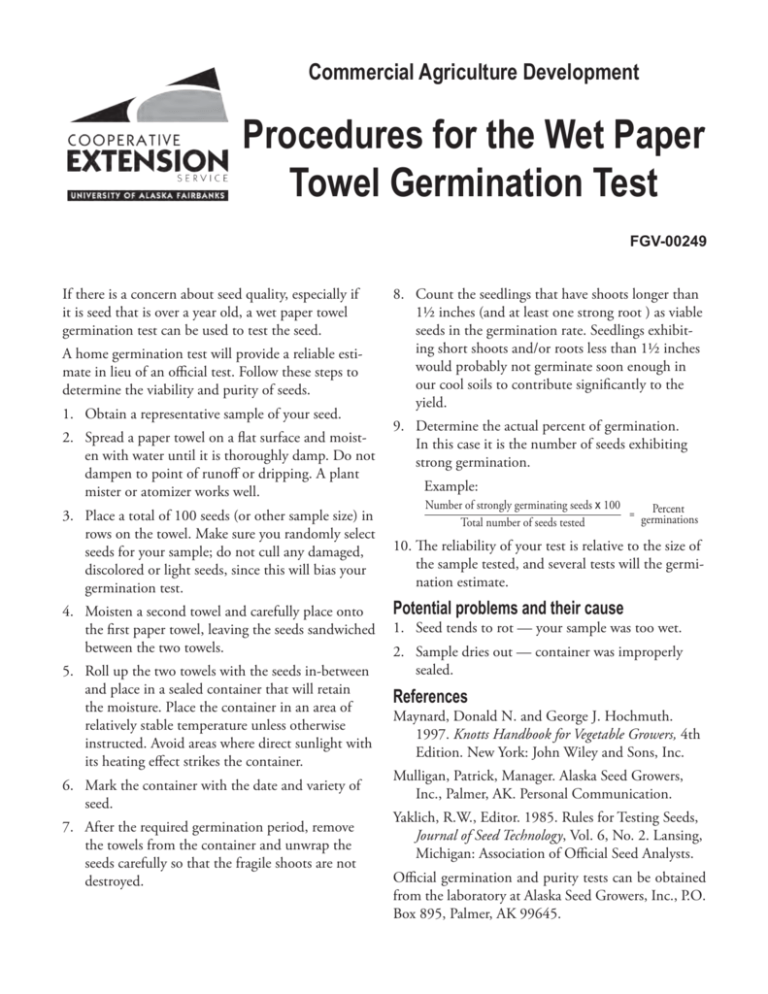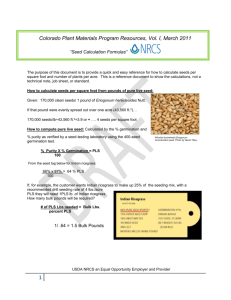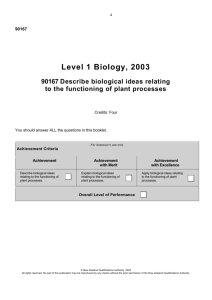Procedures for the Wet Paper Towel Germination Test
advertisement

Commercial Agriculture Development Procedures for the Wet Paper Towel Germination Test FGV-00249 If there is a concern about seed quality, especially if it is seed that is over a year old, a wet paper towel germination test can be used to test the seed. A home germination test will provide a reliable estimate in lieu of an official test. Follow these steps to determine the viability and purity of seeds. 1. Obtain a representative sample of your seed. 2. Spread a paper towel on a flat surface and moisten with water until it is thoroughly damp. Do not dampen to point of runoff or dripping. A plant mister or atomizer works well. 3. Place a total of 100 seeds (or other sample size) in rows on the towel. Make sure you randomly select seeds for your sample; do not cull any damaged, discolored or light seeds, since this will bias your germination test. 4. Moisten a second towel and carefully place onto the first paper towel, leaving the seeds sandwiched between the two towels. 5. Roll up the two towels with the seeds in-between and place in a sealed container that will retain the moisture. Place the container in an area of relatively stable temperature unless otherwise instructed. Avoid areas where direct sunlight with its heating effect strikes the container. 6. Mark the container with the date and variety of seed. 7. After the required germination period, remove the towels from the container and unwrap the seeds carefully so that the fragile shoots are not destroyed. 8. Count the seedlings that have shoots longer than 1½ inches (and at least one strong root ) as viable seeds in the germination rate. Seedlings exhibiting short shoots and/or roots less than 1½ inches would probably not germinate soon enough in our cool soils to contribute significantly to the yield. 9. Determine the actual percent of germination. In this case it is the number of seeds exhibiting strong germination. Example: Number of strongly germinating seeds x 100 Percent = germinations Total number of seeds tested 10.The reliability of your test is relative to the size of the sample tested, and several tests will the germination estimate. Potential problems and their cause 1. Seed tends to rot — your sample was too wet. 2. Sample dries out — container was improperly sealed. References Maynard, Donald N. and George J. Hochmuth. 1997. Knotts Handbook for Vegetable Growers, 4th Edition. New York: John Wiley and Sons, Inc. Mulligan, Patrick, Manager. Alaska Seed Growers, Inc., Palmer, AK. Personal Communication. Yaklich, R.W., Editor. 1985. Rules for Testing Seeds, Journal of Seed Technology, Vol. 6, No. 2. Lansing, Michigan: Association of Official Seed Analysts. Official germination and purity tests can be obtained from the laboratory at Alaska Seed Growers, Inc., P.O. Box 895, Palmer, AK 99645. Seed Germination Test Guidelines Pre-chill and Germination Specific Chemical Crop Test Period (Days) Requirements Alfalfa 70 7 50 Barley, Wheat, Rye 70 7 42°F for 5 days pre-germ 500 77, 68-86 8 50 Bluegrass 70 28 Light 42°F for 5 days pre-germ 10 Brome 70 14 42°F for 5 days pre-germ 200 Buckwheat 70 6 500 Canola/Turnip 70 7 50 Beans 1 Requirements (Fresh; Dormant) Sample Size For Official Test (Grams)2 Temperature1 (°F) Carrot 70, 68-86 14 50 Fescue 70 21 42°F for 5 days pre-germ 30 Kale 70, 68-86 10 41°F for 3 days pre-germ; add light to break dorm 50 Cauliflower, Broccoli, Cabbage, Brussel Sprouts 70, 68-86 10 41°F for 3 days pre-germ; add light to break dorm 50 Lettuce 68 7 Light 50°F for 3 days or test at 59°F 50 Oats 70 10 42°F for 5 days pre-germ 500 Peas 68 83 50 Radish 68 6 50 Spinach 59 21 50 Sweetclover, Clovers 70 73 50 Timothy 70 10 Light 42°F for 5 days pre-germ 10 Tomato 70, 68-86 14 Light light 50 Keep substrate on dry side; remove excess moisture Temperature: A single number indicates a constant temperature. Two numerals separated by a dash indicate an alternation of temperature: the first temperature held for 16 hours and the second held for 8 hours per day. When both methods are indicated, the alternation of temperatures is the preferred method. 2 454 grams = 1 pound. 3 Hard seeds: Seeds that remain hard at the end of prescribed test because they have not absorbed water, due to an impermeable seed coat, are to be counted as “hard seed.” If at the end of the germination period provided there are still present swollen seeds or seeds of these kinds that have just started to germinate, all seeds or seedlings except the above-state shall be removed and the test continued for five additional days and the normal seedlings included in the percentage of germination. www.uaf.edu/ces or 1-877-520-5211 Steve Seefeldt, Extension Faculty, Agriculture and Horticulture. This publication was originally developed by Donald M. Quarberg, Agriculture Agent. Published by the University of Alaska Fairbanks Cooperative Extension Service in cooperation with the United States Department of Agriculture. The University of Alaska Fairbanks is an affirmative action/equal opportunity employer and educational institution. ©2014 University of Alaska Fairbanks. 5-81/DQ/5-14 Revised July 2012






